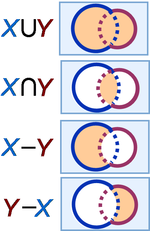Venn diagram: Difference between revisions
imported>John R. Brews (→Examples: source) |
imported>John R. Brews m (→Examples: link) |
||
| Line 5: | Line 5: | ||
==Examples== | ==Examples== | ||
Suppose X and Y are sets. Various operations allow us to build new sets from them, and these definitions are illustrated using the three Venn diagrams in the figure.<ref name=Oakhill/> | Suppose X and Y are [[Set (mathematics)|sets]]. Various operations allow us to build new sets from them, and these definitions are illustrated using the three Venn diagrams in the figure.<ref name=Oakhill/> | ||
==== Union ==== | ==== Union ==== | ||
Revision as of 12:17, 4 July 2011
A Venn diagram is an arrangement of intersecting circles used to visually represent logical concepts and propositions.
Examples
Suppose X and Y are sets. Various operations allow us to build new sets from them, and these definitions are illustrated using the three Venn diagrams in the figure.[1]
Union
The union of X and Y, written X∪Y, contains all the elements in X and all those in Y.
Intersection
The intersection of X and Y, written X∩Y, contains all the elements that are common to both X and Y.
Set difference
The difference X minus Y, written X−Y or X\Y, contains all those elements in X that are not also in Y.
Complement and universal set
The universal set (if it exists), usually denoted U, is a set of which everything under discussion is a member. In pure set theory, normally sets are the only objects considered. In that case, U would be the set of all sets. However, one may also consider sets that are collections of numbers, or colors, or books, for example; see Set (mathematics).
In the presence of a universal set we can define X′, the complement of X, to be U−X. X′ it contains everything in the universe apart from the elements of X.
References
- ↑ Alan Garnham, Jane Oakhill (1994). “§6.2.3b: Venn diagrams”, Thinking and reasoning. Wiley-Blackwell, pp. 105 ff. ISBN 0631170030.
